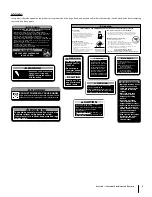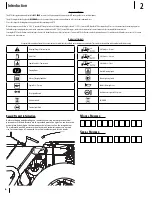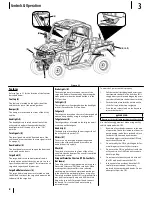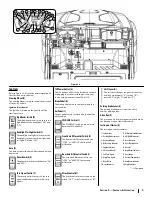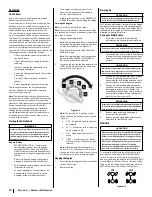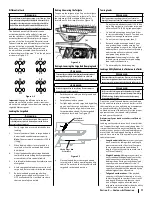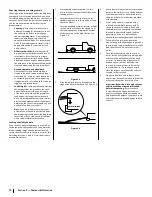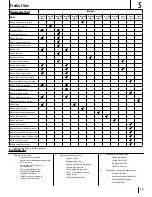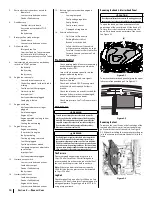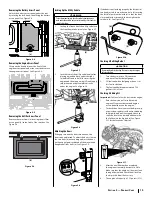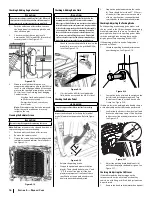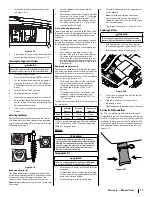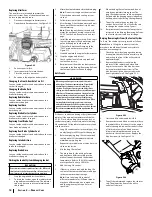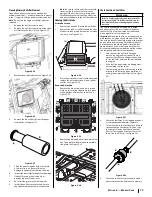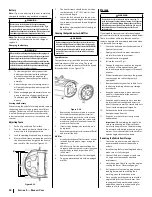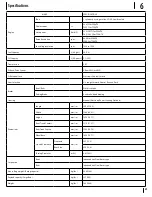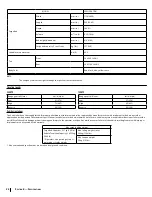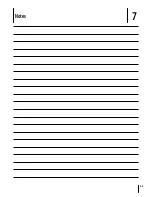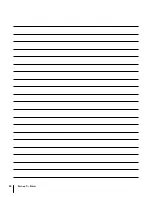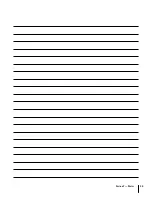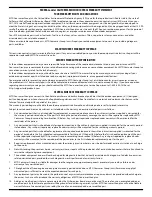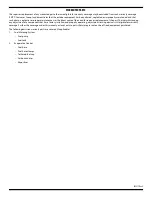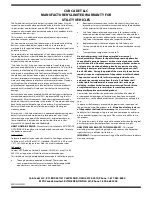
19
S
ection
5 — P
roduct
c
are
Cleaning Primary Air Filter Element
Open the air cleaner cover once a week under
ordinary conditions — or daily when used in a dusty
place — to get rid of large particles of dust and dirt.
Note:
Do not run the engine with filter element
removed.
1.
Remove the air filter access panel.
2.
Remove the air filter cover (a) from the three
air filter cover holders (b). See Figure 5-25.
(a)
(b)
(b)
(b)
Figure 5-25
3.
Remove the air filter element. See Figure 5-26.
Figure 5-26
4.
Remove the inner filter (a) from the paper
element (b). See Figure 5-27.
(a)
(b)
Figure 5-27
5.
Clean the paper element with a soft brush
or low pressure air. Be careful not to
damage the paper pleats during cleaning.
6.
Inspect the inner filter for deposits or damage.
7.
If either filter are excessively dirty or
damage replace filters as a set.
8.
Re-install the primary air filter element.
9.
Install the air filter case cover and be sure
the crankcase breather hose is connected.
Note:
Be sure to refit the air filter cover with
the arrow (on the rear of air filter cover)
upright. If the air filter cover is improperly
fitted the evacuator valve will not function
and dust will adhere to the air filter element.
Cleaning the Air Intake
Air Intake Screen
1.
Remove the hood and locate the air intake.
2.
Remove the rubber seal (b) around the front
of the air intake (a) and remove the air intake
screen (c). See Figure 5-28.
(a)
(b)
(c)
Figure 5-28
3.
Rinse the air intake screen (c) with water and
replace the air intake screen (c) and rubber
seal (b). See Figure 5-28.
Drain the Air Intake
1.
Remove the nine Allen-head bolts (a) and
washers (a) securing the middle skid plate
to the bottom of the utility vehicle. See
Figure 5-29.
(a)
(a)
(a)
(a)
(a)
(a)
(a)
(a)
(a)
Figure 5-29
2.
Remove the drain and allow the water to run
out. Then replace the drain and the middle
skid plate. See Figure 5-29.
(a)
Figure 5-30
Check Fuel Line & Fuel Filter
WARNING
Be sure to stop the engine and remove the key. Check the
fuel lines periodically. The fuel lines are subject to wear
and old fuel may leak onto a running engine which may
cause a fire.
The fuel line connections should be checked
annually or every 100 service hours whichever
comes first. The fuel line is made of rubber and
wears regardless of service period.
Important:
When the fuel line is disconnected for
maintenance or repair, close both ends of the fuel
line with a piece of clean cloth or paper to prevent
dust and dirt from entering. Particular care must
be taken not to allow dust and dirt into the fuel
pump entrance. Even a small amount of dust or
dirt cause premature wear and the malfunction of
the fuel pump and injector components.
1.
Park the vehicle on a flat surface and
remove the engine access panel. There is
a primary fuel filter on the gas tank and an
in-line fuel filter between the gas tank and
the engine.
2.
If the fuel line and clamps are damaged or
deteriorated, replace them.
3.
There are two main lines (a) coming into the
primary fuel filter (b) and one main line (c)
exiting the primary fuel filter (b). See Figure
5-31.
(a)
(b)
(a)
(c)
Figure 5-31
4.
Check the fuel filter if it is clogged by debris
or contaminated with water, replace it.
5.
To remove the in-line fuel filter, use pliers to
squeeze tabs on the clamps (b), then slide
the clamps (b) away from the in-line fuel
filter (a). Twist and pull the fuel lines off of
the in-line fuel filter (a). See Figure 5-32.
(a)
(b)
(b)
Figure 5-32
6.
Check the in-line filter (a) for debris and/or
water contamination. Replace as necessary.

